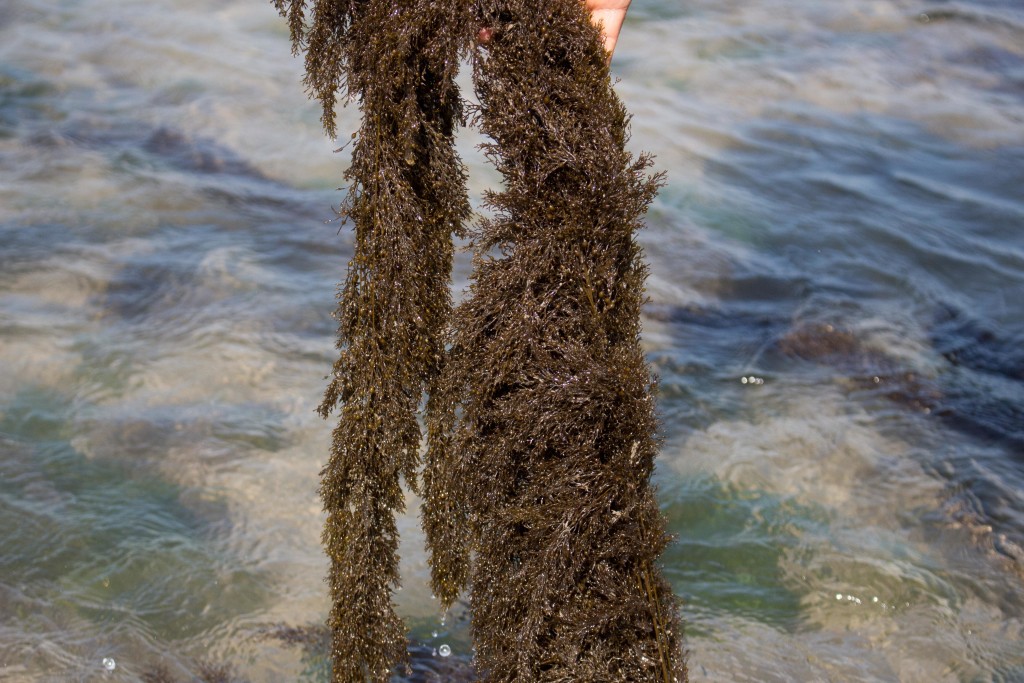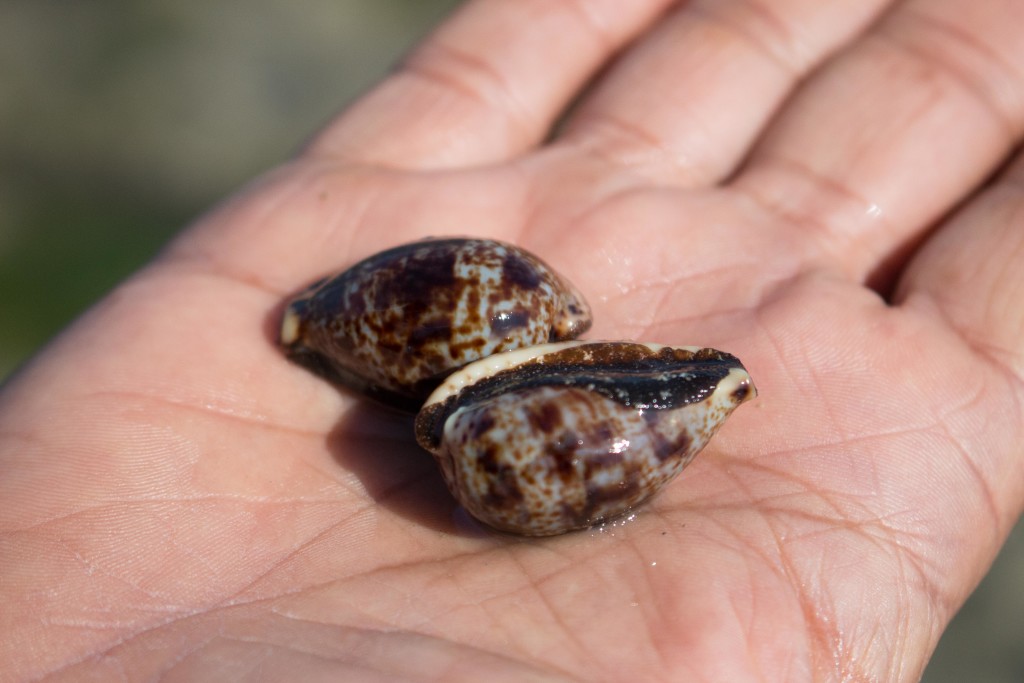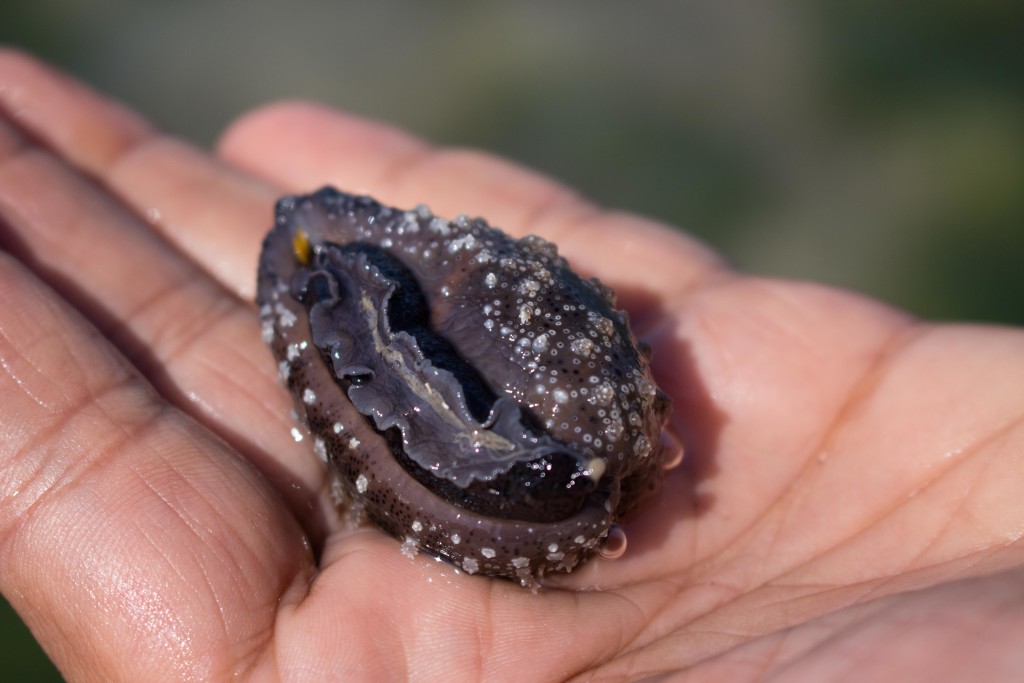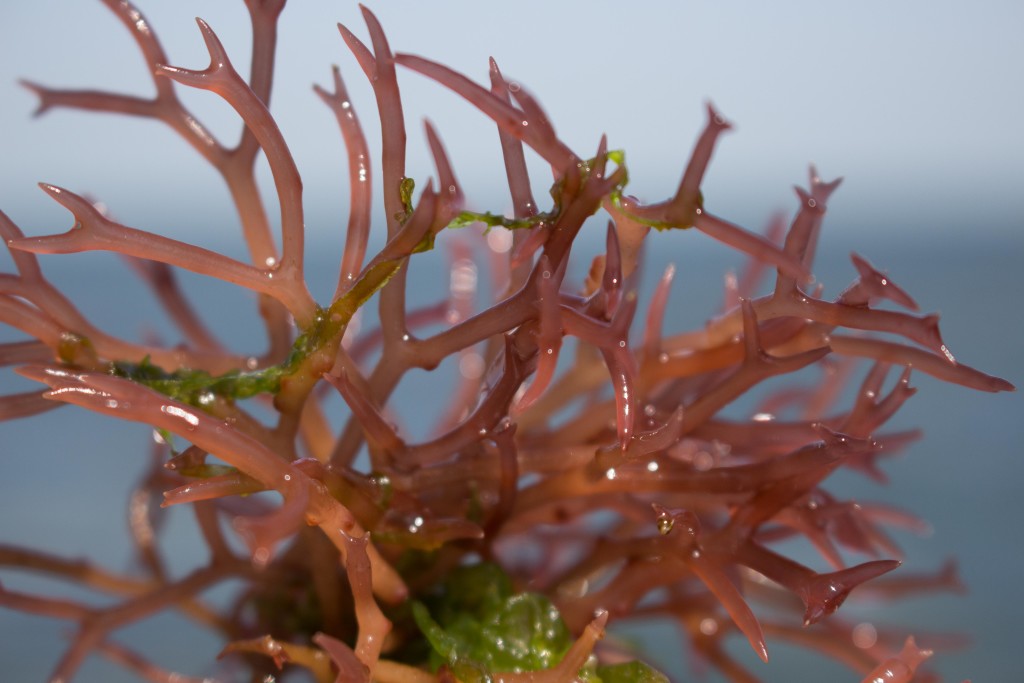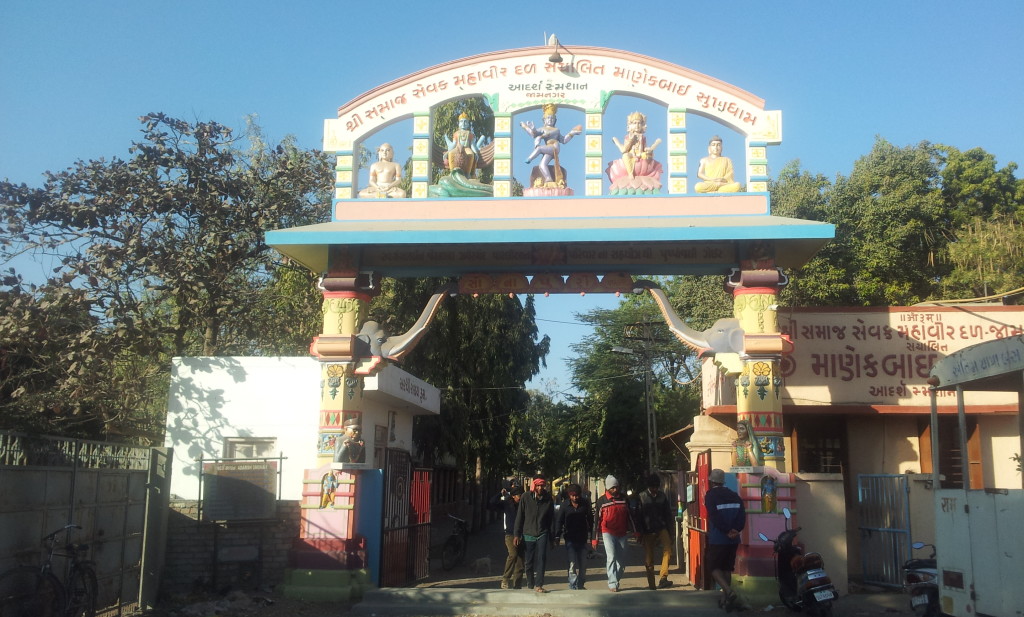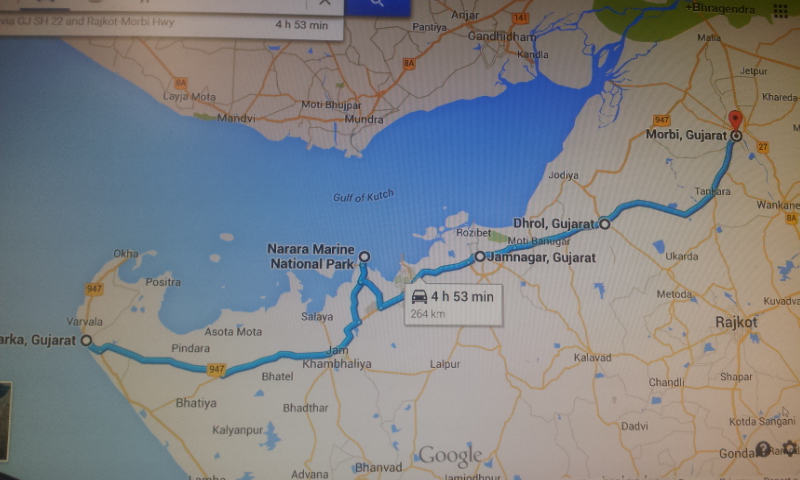Gujarat Tour Diary: Day 11| Narara Marine National Park to Morbi via Jamnagar
(If you have come to this page while searching for some travel related information of Gujarat, I suggest you start from Day 0 of this travelogue.)
As we could not visit all the places in Dwarka yesterday, today early morning we tried to visit some other important places.
Gomati Ghat Temples
{On the banks of river Gomti, there is a Shiva temple, as well as smaller shrines of Lord Rama, Krishna and Sudama around the ghat, where pilgrims have worshiped for at least 100 years. One can also hire a boat and move across the river to get a panoramic view of Dwarka; source: wikipedia/internet}
Panchtirth
{It is on the other side of Gomti River. There are 5 small (2’ X 3’) wells within 500 meters range. Water of each well has different taste. Water is not salty though there is sea surrounding this area;source: wikipedia/internet}
Gita Mandir
{A marvelous and spectacular shrine on the western part of the city, the Gita Mandir tries to project the values of the sacred book Bhagavad Gita. This marble structure is a marvel in terms of artistic expressions and at the same time it imparts a saintly feeling to all those delve in to its holy premises. Built in the year 1970 by the leading business tycoons, the Birlas, the temple stand proudly as a standing ovation to the richness and elegance to the much revered scripture, Gita. Highly carved walls and embellished ceilings of the temple are inscribed with the prominent hymns of Bhagavad Gita. Another alluring feature of the temple is that any voice heard in hall will be echoed, which spells out a distinct feeling; source: wikipedia/internet}
Rukmini Devi Temple
{Rukmini temple is located 2 kms away from Dwarka’s Jagat Mandir. Maybe 2500 years old, but its domed mandapa and stepped sanctuary cannot be older than the 12th century in its present form. The exterior of the Rukmini Temple is richly carved. It has a panel of sculpted naratharas (human figures) and a panel of sculpted gajatharas (elephants) at the base. The traditional spire of the main shrine contrasts strongly with the hemispherical dome of the pavilion. The garbhagriha has a recessed seat on which the present image of Rukmini, wife of Lord Krishna, was consecrated; source: wikipedia/internet}
Due to shortage of time, we saw only Gomati Ghat, and skipped other places. Then we checked out of our hotel room. We had our breakfast at TN Restaurant at around 7 am. Then we left towards Narara.

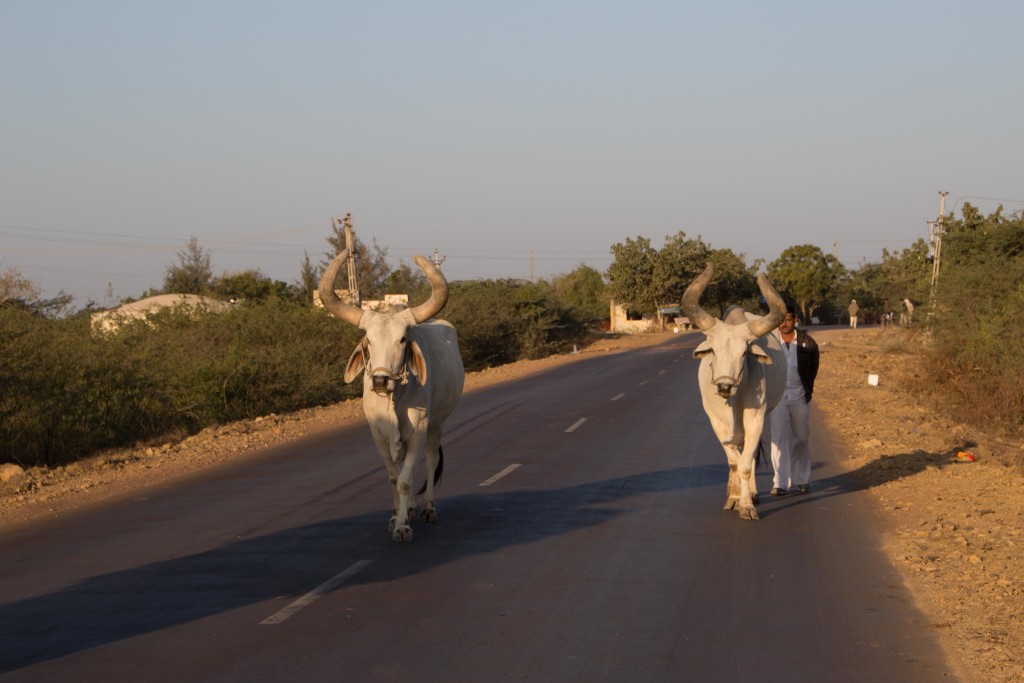
Narara Marine Park (NMP)
{Although Narara is an island, it is well connected with the mainland without sailing. It is also known for its vast inter-tidal zone, facilitating viewing of marine invertebrates. Narara is as good as Pirotan Island with similar Marine life and Birds. During low tide the sea water recedes to as far as five km and gradually creeps back inundating the entire vast emptiness and the mangroves by noon.
Before visiting find out when the low tide is in the area. Wear a rubber based foot wear with good straps which will keep firm. As you will be wading through water for some hours, there is tendency to footwear becoming uncomfortable. Wear knee height garment. Long trousers or full covered attire is not recommended as you will be in water. Carry sufficient drinking water, sun-cap, towel, goggles etc. Be prepared to walk over 4-5 hours with no shelter or bench to take rest. Venturing the visit without a guide will only lead to dissatisfaction. You need their experience to identify the real treasure. There is only informal arrangement from the dept to hire a guide.
Principal CCF, Gandhinagar – 382010, Gujarat. Ph: 079-23254100
Goyal, PCCF, WL 07923254125; Sharma, CF, WL 07923254131;
Chanpura, WL 07923254133
Deputy CCF, Marine National Park, Jamnagar. Ph: 0288 2679357; source: wikipedia/Internet}
If you are an ordinary tourist (I mean who travel through Tour Operators), then you are most likely to envy us. Because, NMP is a killer. Like those Sea Temples, NMP is also a unique place in India. Again, if you have not seen NMP, then your Gujarat tour is incomplete.

Ok, first things first. Few websites tell us that permission is required from Jamnagar or Gandhinagar Forest Department to visit this place. As we were going to NMP from the opposite direction, we decided to take a chance and went there. We reached NMP around 9.30 am.
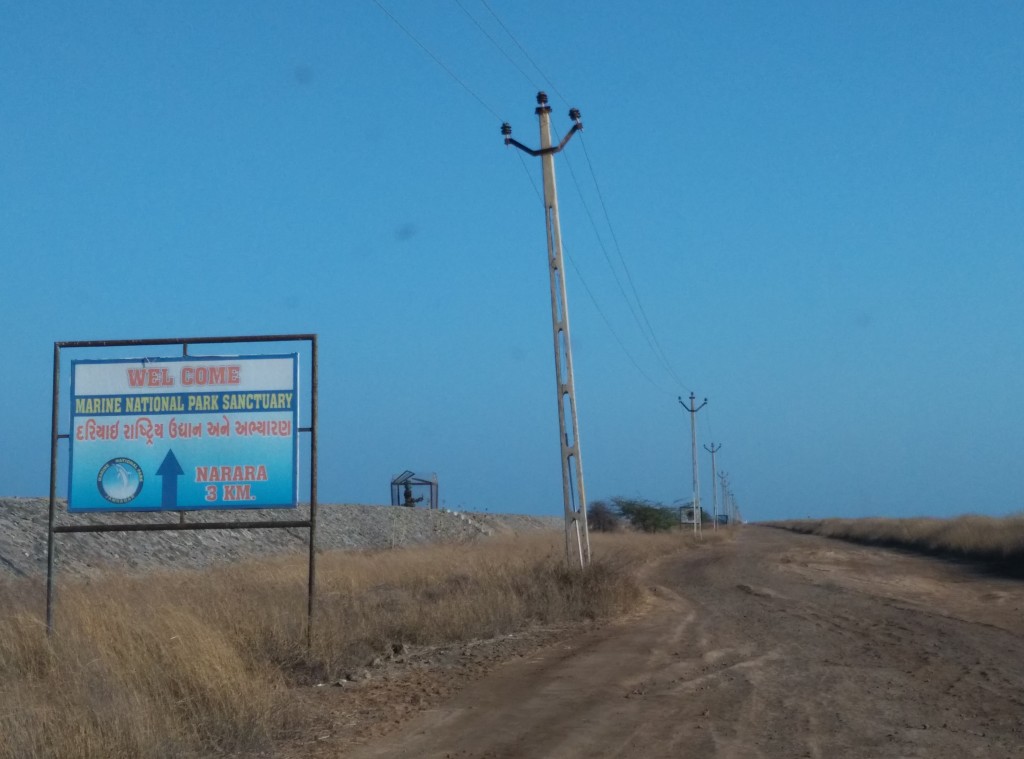
We parked our car and went to the reception center. This NMP comes under Forest Dept, Wild Life Division. So I was expecting a typical forest office filled up with cobwebs, old furniture, files and an old-aged unfriendly forest officer etc. But I got the shock of my life.
For a moment, I got confused whether this is an MNC office or Forest Dept office. Not that it was so hi-fi. But a smart looking young lady was managing the show. She welcomed us with a smiling face, collected the fees and gave the necessary permits. (Entry fee Rs 100/ per person; Camera Rs 100/).
So what does a ‘Tourist Friendly State’ mean to a tourist? I have traveled in many parts of India. I have not come across a state like Gujarat so far. Beautiful roads where we can drive at 100+ kmph, fooding and lodging at regular intervals in all the major roads, no power cuts, no red-tape-ism, no ‘VISITORS NOT ALLOWED’ boards, easy permits to see the places, lots of parking facilities at tourist places, clean environment, clean toilets, so on and so forth.
We have seen Modiji advocating positive tourism through out India. He has also liberalized Visa On Arrival for 150 odd countries now. And as a disciplined citizen and traveler, we also have lots of responsibility to maintain all these facilities.
Ok, let me come back to NMP. After taking the permits, we met the guide Najeem (084697 15325). He asked us to wait till around 11 am or so, so that the water recedes completely. Now I don’t have to explain anything more. You have experienced the Stambeshwar and Nishkalank Sea Temples, as well as Alang. So the same theory holds good at NMP also.
Strictly speaking Narara is not an island. It is a vast plain area that emerges out of sea during low tides. And during high tides, the water goes up by 10 – 15 feet. It is very essential that we venture out only after the water has receeded completely. Because, if there is water, then we can’t see the marine life properly.
So what is this NMP and what all can we see here? You have seen lots of marine life in TV channels like National Geographic, Discovery and Animal Planet. They show lots of corals, variety of colourful fish, and other creatures. Now come to NMP and personally experience the same.
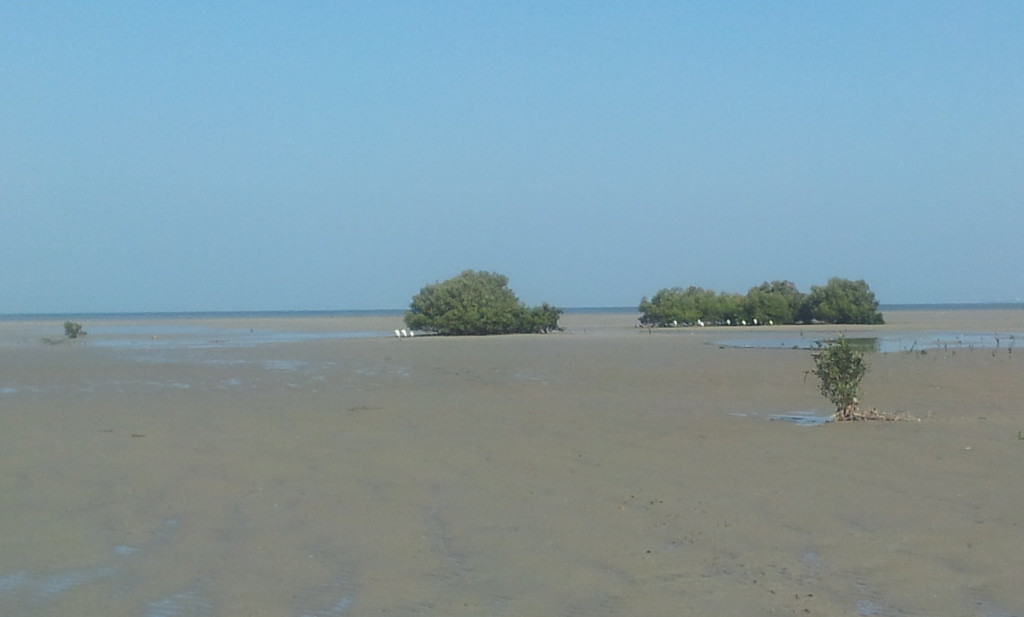


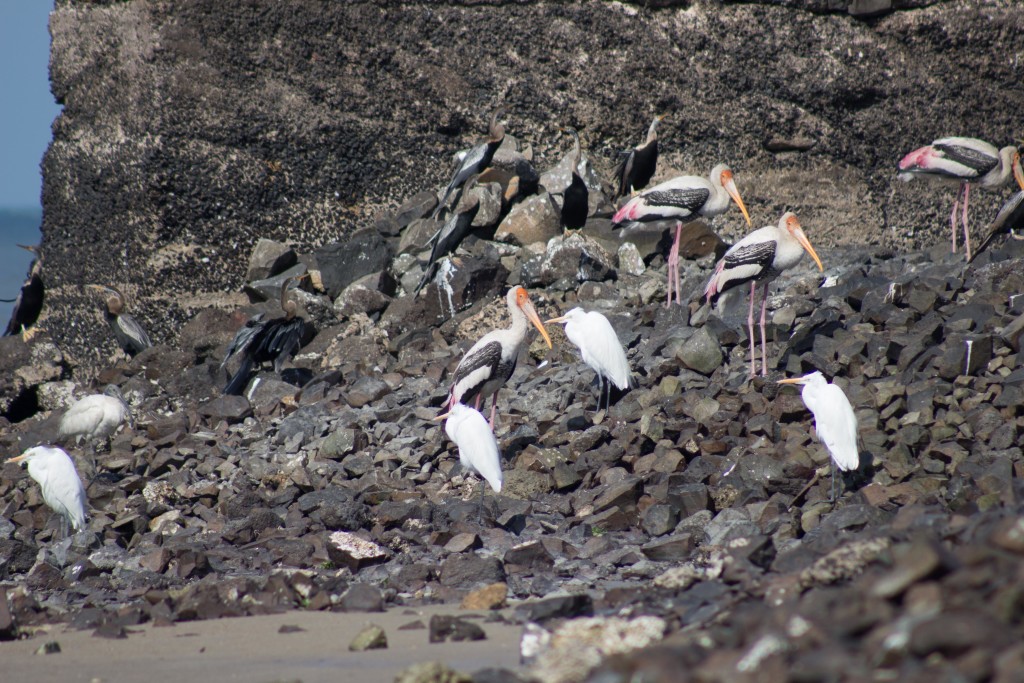
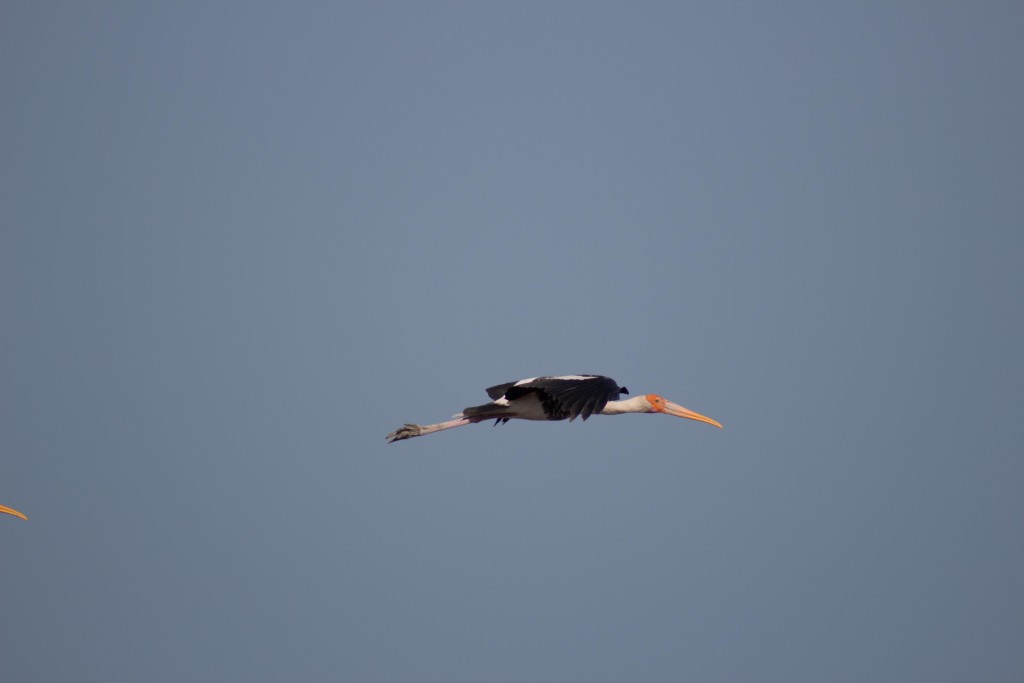
At 11 am we went out. The water has receded and we started walking. All along the way, the guide was showing and explaining different types of corals, star fish, and other types of fish etc.









Probably we would have walked for 2 – 3 kms. Then came the first thriller. The guide caught hold of a puffer fish. Oh, we have never seen such a creature before.

(http://www.softschools.com/facts/animals/puffer_fish_facts/59/)
Now let me tell you one more thing. The guide was quite knowledgeable. He knew what to touch and what not to touch. For certain varieties, he used to say ‘they should not be taken out of water’.
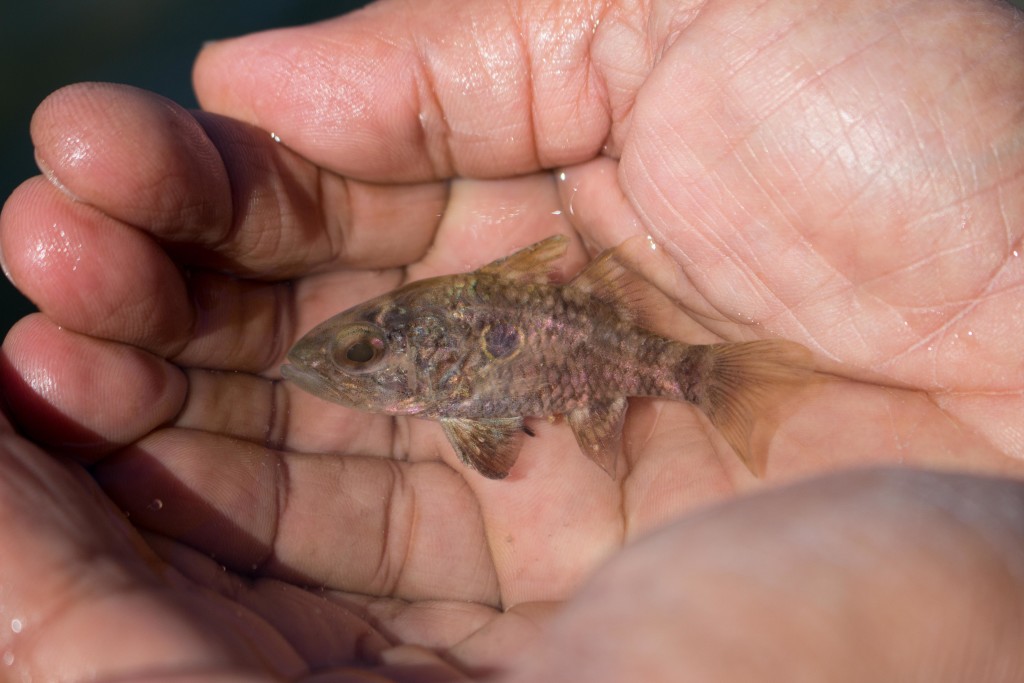

We went further and that was sort of end of the shallow zone. And that was also the climax place. He caught an octopus. Oh God, I had physically seen an octopus in my school Laboratory only. Here he allowed us to even touch and feel it. He told us that there are two varieties of Octopus live here, and this one can be touched and can even be gently taken out of water.
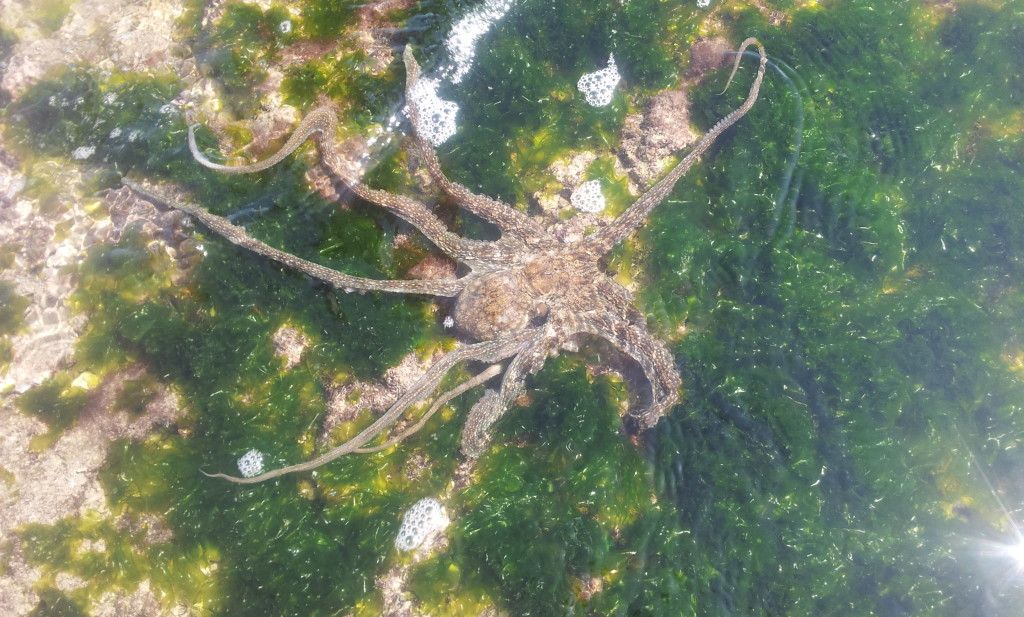
(http://www.softschools.com/facts/animals/octopus_facts/23/)
And it was time for us to return, as were getting late for our next destination. We paid him the fees (Rs 300 + Rs 50 tips), and returned profusely thanking him.

We left Narara and came to Jamnagar. (All along the way, we could see lots of oil refineries)
Jamnagar
{The city was built up substantially by Maharaja Kumar Shri Ranjitsinhji in the 1920’s, when the district was known as Nawanagar. Jamnagar is situated at the bank of River Rangmati. Jamnagar is also known as Saurashtra.}
Pratap Vilas Palace
{It was built by Jam Ranjitsinhji. It has European architecture with Indian carvings that give it a totally distinct appeal. It was built as a mimic of Victoria Memorial Building of Calcutta but the domes built on it are according to Indian architecture, out of which 3 domes are made of glass. Carvings of creepers, flowers, leaves, birds and animals on the columns make the palace lively; source: wikipedia/internet}
We went to the Palace building. On arrival, we were told that public are not allowed to see the palace, as it is a private residence of the erstwhile rulers.
Lakhota Lake, Fort and Museum:
{This small palace, on an island in the middle of the Lakhota Lake, once belonged to the Maharaja of Nawanagar. This fort like palace has semi-circular bastions, turrets, a pavilion with guard-rooms housing swords, powder flasks and musket loops. An arched stone- bridge with balustrade connects the Lakhota Palace with the town. It is reached by the northern side of Ranmal Lake. Closed on Wednesdays; source: wikipedia/internet}
Unfortunately to our bad luck, we were here on a Wednesday, their weekly off day.


Bhujio Kotho
{Bhujio Kotho enjoys a distinct place among the tourists because of its height and circumference. It is on the bank of the Lakhota Tank, near Khambholiya Gate. This monument having five floors was believed to be constructed for protection during the invasions. On the first floor, there are guns placed in each directions and in the walls, holes are made to place the rifles. On the upper floor, a tank is constructed to store water and on its peak a dancing peacock is placed; source: wikipedia/internet}
This is permanently closed for visitors; hence we had a look of it from out side.
Bala Hanuman Temple
{The Bala Hanuman Temple is on the south-eastern side of Lakhota Lake. The temple is famous for the continuous 24-hour chanting of ‘Sri Ram, Jai Ram, Jai Jai Ram’, since 01-08-1964. This devotion has earned Bala Hanuman Temple a place in the Guinness Book of Records. Early evening is particularly a good time to visit the temple.
Ph: 0288 2558196; Time: 6 am – 12 noon; 4.30 pm – 10 pm}


There is a proverb in Kannada, which means “Popularity (Keerti) is bigger than the Statue (Murti)”. This temple is an excellent example of the proverb.
Very close to the Bhujio Kotho, on the side of the Lakhota Lake, this temple of Hanuman exists. And as said, some one or the other will be chanting ‘Sri Ram, Jai Ram, Jai Jai Ram’, 24 hrs x 365 days, since 01-08-1964. I also joined the group for a couple of minutes and enjoyed the atmosphere.
‘What will they do if there is no body to sing the Bhajan?’ we asked. They told us that there is a group of volunteers in such emergency situations. Enjoy the video which will give you the over all picture of the temple and chanting.
Bhid Bhanjan Temple
{Near Bedi Gate, west of the town hall is the Bhid bhanjan temple. The temple displays a local style. The intricate silver work on the doors is a testament to the craftsmanship that is found in Jamnagar even today}

Cremation Park:
{For a complete sense of the sacred in Jamnagar, you should also visit the cremation park, known as the Manekbai Muktidham, built in 1940 near the center of the city. The surprisingly pleasant atmosphere of this lovingly designed garden, with statues and murals and a library, brings us in contact with death in such a way that we are free from fear or aversion, and can see death as simply a stage of life, as depicted by one of the artistic representations in the park}
This is really funny. No where else I have visited Cremation Parks like this. Only in Gujarat. (Of course, I have seen few World War Memorials, but that is a different matter). Any thing and every thing that is worth from tourist point of view attracted us. And what is the verdict about this place? Yes, go and see it. Because you don’t get such ‘Harishchandra Ghats’ to see everywhere.
Manekbai Muktidham

Willingdon Crescent
{The impressive Willingdon crescent was constructed by Jam Ranjit Singh, inspired by his European journey. It comprises arcades of cusped arches, larger on the ground floor and smaller on the upper storey, pilasters on the curving walls, and balusters on the parapet. The statue of Jam Saheb is situated in the centre of the crescent}
We left Jamnagar. As said earlier, we skipped Rajkot from our itinerary. We straight away headed towards Morbi, via Dhrol. At Dhrol, it was very difficult to locate our tourist interest palace.
Darbargadh Palace at Dhrol
{East of Chandi Chowk is Darbar Gadh, the old royal residence, built in 1540 but extended over the years as can be seen by the mix of architectural styles, also representing the fusion between Rajasthani and European elements. The semi- circular palace complex consists of a number of buildings with very fine architectural features and detailing. It has some fine examples of stone carvings, wall paintings, fretwork jali-screens, ornamental mirrors, carved pillars and sculpture. The walls outside have carved jarokha balconies in the Indian tradition, a carved gate and Venetian-Gothic arches; source: wikipedia/internet}
We were confused, because the road to the palace was through some narrow crowded bye lanes. And no one was aware of such a ‘Palace’. And when we finally arrived there, we were shocked to see a Ladies College and Hostel. Yes, the palace was converted into an educational institution. As it was late in the evening, and it was for the fair sex, the watchman denied permission for us to go inside.
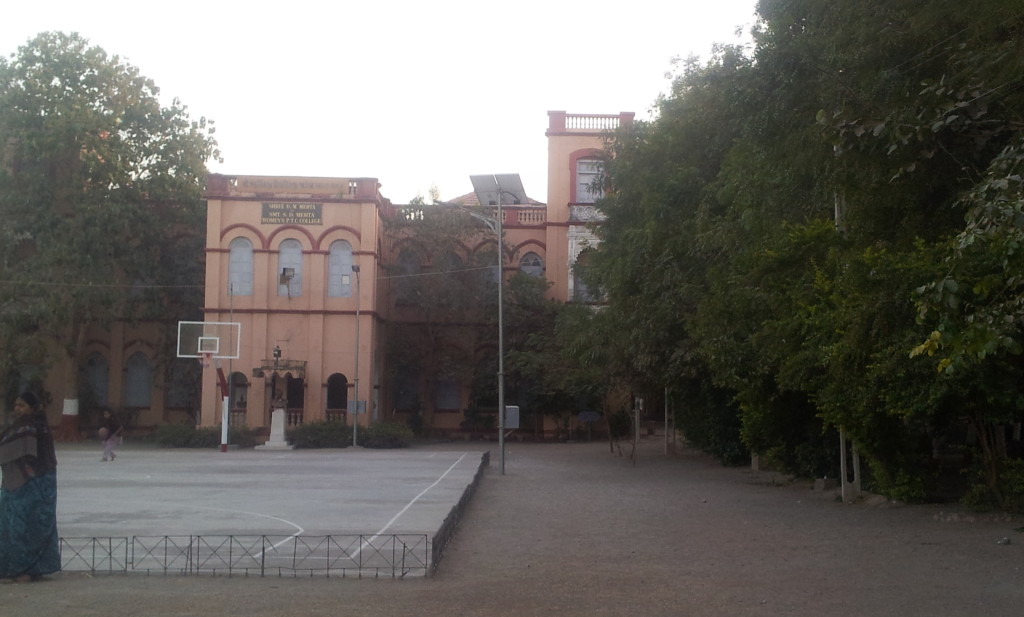
From here, we went to Morbi. It was nearing 8.00 pm, our longest drive in terms of time, so far in our tour. Again, there is no BAPS SNM at Morbi. So while on the drive, we searched the internet for budget friendly Hotels at Morbi. We called few of them and found out to be one among them to be reasonably priced. So without wasting much time, we were able to check into the Lodge.
Hotel Thakur, Jail Road, Morbi. Ph: 02822 231928. Rs 640/
Today’s route from Google Maps
Total distance covered: 290 kms.
On Day 12, I visit Indian Wild Ass Sanctuary in the Little Rann of Kutch with the help of two local cow-herders. Let’s go…
Read previous day’s account| Read next day’s account

